Carbon sink trade brings hope to China’s struggling forestry industry after logging ban
By Shan Jie in Hulun Buir Source:Global Times Published: 2019/5/22 17:28:40
○ A northeastern town that used to rely on logging now sets new hope in developing carbon sink trade
○ China initiated the carbon emissions trading system in 2011, of which transaction values hit over $860 million in 2018
○ The national carbon sink trade market is expected to open in a few months, said an expert
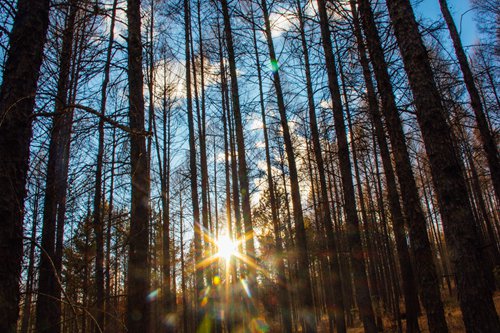
Wuerqihan looks like it was sealed by time.
The town center mainly features old single-storey houses, a sign of a lagging-behind rural area in China. Not many infrastructural construction projects could be spotted here. The roads are mainly built by cement or earth. A water tower with colorful painting is the most outstanding building in town.
It is not a common scene in most other places in China, where construction projects are busily underway.
But one could still notice the past prosperity of this town, where timber buyers from around the country gathered to trade - restaurants of different cuisines, small inns and shops are still everywhere.
Wuerqihan is a town deep in the forests of the Great Khingan Mountains of North China's Inner Mongolia Autonomous Region. It is built around the compound of Wuerqihan Forestry Bureau under Inner Mongolia Key State-owned Forestry Administration.
The town used to rely on logging, which brought in a consistent stream of wealth.
However, the booming scene started to decline 10 years ago.
Processing in Wuerqihan log yard came to an end in 2015, two years before China completely halted commercial logging in natural forests.
Since then, the forestry bureau switched its focus from logging to planting trees and fire prevention.
The change of functions hugely impacted the forestry industry. Wuerqihan forestry bureau saw a decline immediately.
It is a similar situation in other places that were used to relying on forests in China.
In 2011 China initiated the carbon emissions trading system, which brought new hope of revival to the forestry industry.
The Wuerqihan bureau actively joined in the trend.
Bao Guoqing, Supervisor of Forest Resources Senior Engineer of Carbon Sequestration at Inner Mongolia Key State-owned Forestry Administration, said that the office is making efforts to build Wuerqihan a standard model of carbon trade in China.
The bureau actively participated in the national carbon trade market construction and developed carbon trade categories, he told the Global Times.
China's carbon trading saw transaction values hit over 6 billion yuan ($860 million) since June 2013, with traded emission quotas exceeding 270 million tons, the Xinhua News Agency reported in November 2018.
Media reported in early May that China is behind schedule on its preparation of launching the carbon market, but Bao said on Tuesday that the carbon sink trade market could be expected to open in months.
Yesterday's glory
The log yard used to be the heart of Wuerqihan, but now it is abandoned.
The tracks for transporting logs are rusting. Wooden cutting platforms will rot in a few years.
Withered weeds have covered the dark soil in the yard, which equals the length of 50 soccer fields.
It is quiet. Even footsteps sound loud.
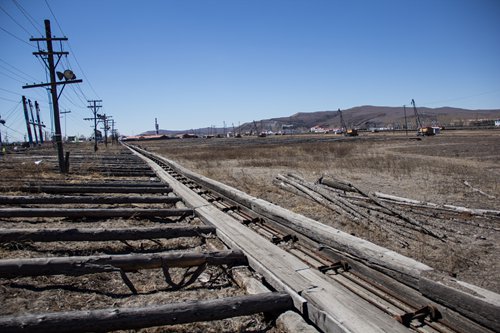
"These two will be antiques here," Yu Detao, chief secretary of the log yard, said, pointing at two logs left on the floor.
There used to be 300,000 cubic meters of logs processed each year in the yard into different sizes according to client needs. Then the logs were transported to other parts of China.
"A total of 600 workers worked together, 24 hours non-stop here," Yu said, "Even in winter, when the temperature was -20 C."
Trading the processed logs constantly brought wealth to Wuerqihan.
"People envied us who worked in the forestry system," an employee at the Wuerqihan publicity department, surnamed Ma, said.
In February 2015, the Central Committee of the Communist Party of China and the State Council released a plan on reforming State-owned forestry farms. The documents demanded that related enterprises could only "downsize departments and employees."
"Employees could leave the company, but we are not allowed to recruit new ones," Ma said.
The historic task of forest industry groups is completed, said a report on the website of National Forestry and Grassland Administration.
The change of functions in forestry bureaus changed people's lives.
Previously, there were more than 600 people working in the log yard. But now only 100 are left, working on fire prevention.
Many employees in Wuerqihan bureau were distributed to work on firefighting or tree planting. Some are doing both.
New direction
In 2014, the Inner Mongolia Key State-owned Forestry Administration of the Greater Khingan Mountains set a goal to build China's largest carbon trade base, and its attached bureau Wuerqihan actively joined in as one of the six pilots provincial markets.
In 2017, a carbon sink office was established here, aiming to promote building the trade market and fostering the talent.
China initiated the carbon emissions trading system in 2011, which includes power generation, iron and steel production and cement manufacturing sectors in seven provinces and municipalities, according to the Xinhua.
Under the scheme, enterprises are assigned emission quotas, and those producing more than their share of emissions are allowed to buy unused quotas on the market from those that cause less pollution, according to Xinhua.
Li Gao, a senior official of the Ministry of Ecology and Environment, said at a press conference in November 2018 that China will advance the construction of the carbon trading market step by step and gradually expand industries, trading entities and categories that participate in the carbon market.
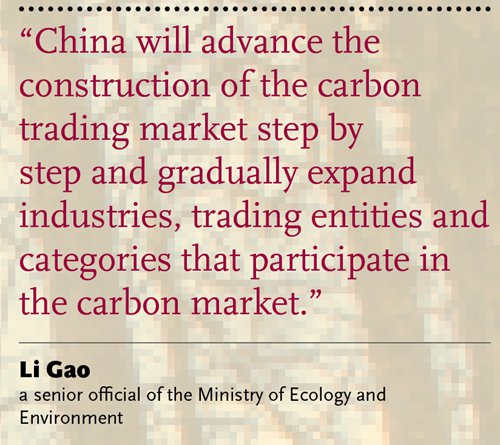
Since 2013, more than 100 forest carbon sink projects across China have been filed. A total of 508 million hectares of artificial forests have been built in five years, People's Daily reported in January 2018.
According to China's commitment to the Paris Agreement, it will have to cut carbon emissions per unit of GDP by 60 to 65 percent by 2030 from the 2005 level. By the end of 2017, China cut carbon dioxide emissions per unit of GDP by 46 percent from the 2005 level, fulfilling its commitment to reduce CO2 emissions by 40 to 45 percent from the 2005 level by 2020.
Acting ahead
The country is piloting carbon trade markets in seven provinces and municipalities, but Inner Mongolia was not among the seven.
Meanwhile, the national carbon trade market that opened in 2017 is only part of the electric power industry, Bao said.
Even though the carbon sink production could not enter the market yet, Wuerqihan bureau understood that developing carbon trade would be the next step for the sustainable development of forestry industry.
They decided to act ahead to create a solid base for the national market.
In 2018, the Wuerqihan bureau developed a sustainable managed carbon sink project with a total of 1,325.74 hectares for 20 years and its total carbon sink production with Chinese Certified Emissions Reduction (CCER) standard would be 44,305 tons of Carbon Dioxide Equivalent, or CO2e.
The project is currently in the process of verifying emission reduction. After this step, the verified carbon units could be issued once the market is completely opened.
"We are just waiting for the opening of China's carbon sink trade market," Bao said.
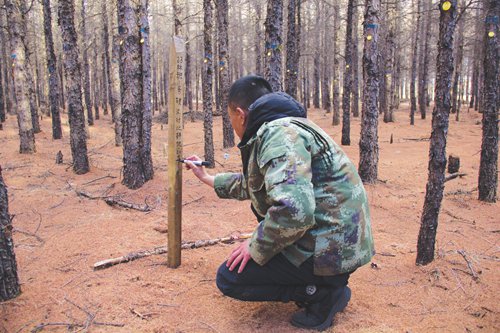
The average price for a carbon sink in the seven pilot programs is about 30 yuan per ton, the highest is Beijing's 77 yuan on Tuesday.
Bao said that Wuerqihan has 590,000 hectares of forests. The majority is natural forests. "The methodology for natural forest carbon sinks is being studied. In the future, the forests will be a great wealth," Bao said.
After the project was initiated, some specialist companies have shown an interest in managing the projects. However, in order to maintain its own talent and grasp the core technologies, Wuerqihan kept the project inhouse and built a team. Including Bao, people working in the office all started from zero, and now have become "experts" in carbon trade.
Moreover, Wuerqihan has already been filed as a Verified Carbon Standard (VCS) Program, the world's most widely used voluntary Greenhouse Gas program with more than 1,300 certified projects. Now an annual of 293,000 tons of carbon sink production of Wuerqihan is listed in VCS, Bao said.
The new dawn
Bao told the Global Times on Tuesday that the market could be opened in a few months, and a more international standard might be applied to replace the current CCER.
A Bloomberg report in early May said that "China is months behind in its preparation to launch a national carbon market."
Ma Aimin, deputy director-general of the National Center for Climate Change Strategy & International Cooperation, was quoted in the report as saying that the delay is due to a regulatory restructuring in 2018, when the new Ministry of Environment and Ecology is now responsible for the carbon market.
China "should still be able to meet its 2020 launch target," the Bloomberg report said, quoting Ma Aimin.
Wuerqihan means "dawn" in Mongolian language.
Now the Wuerqihan people are in the dawn of the carbon market.
"When the national carbon sink trade market is well built, it will be our successful time again," Bao said.
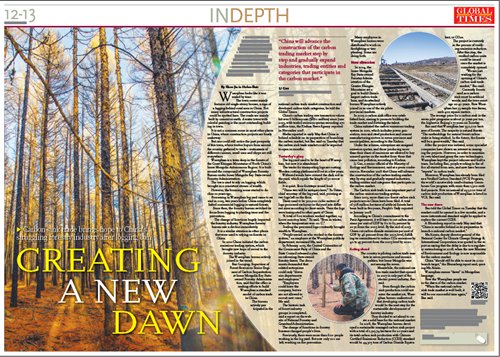
Newspaper headline: Creating a new dawn
○ China initiated the carbon emissions trading system in 2011, of which transaction values hit over $860 million in 2018
○ The national carbon sink trade market is expected to open in a few months, said an expert

The forests in Wuerqihan forestry bureau Photo: Shan Jie/GT
Wuerqihan looks like it was sealed by time.
The town center mainly features old single-storey houses, a sign of a lagging-behind rural area in China. Not many infrastructural construction projects could be spotted here. The roads are mainly built by cement or earth. A water tower with colorful painting is the most outstanding building in town.
It is not a common scene in most other places in China, where construction projects are busily underway.
But one could still notice the past prosperity of this town, where timber buyers from around the country gathered to trade - restaurants of different cuisines, small inns and shops are still everywhere.
Wuerqihan is a town deep in the forests of the Great Khingan Mountains of North China's Inner Mongolia Autonomous Region. It is built around the compound of Wuerqihan Forestry Bureau under Inner Mongolia Key State-owned Forestry Administration.
The town used to rely on logging, which brought in a consistent stream of wealth.
However, the booming scene started to decline 10 years ago.
Processing in Wuerqihan log yard came to an end in 2015, two years before China completely halted commercial logging in natural forests.
Since then, the forestry bureau switched its focus from logging to planting trees and fire prevention.
The change of functions hugely impacted the forestry industry. Wuerqihan forestry bureau saw a decline immediately.
It is a similar situation in other places that were used to relying on forests in China.
In 2011 China initiated the carbon emissions trading system, which brought new hope of revival to the forestry industry.
The Wuerqihan bureau actively joined in the trend.
Bao Guoqing, Supervisor of Forest Resources Senior Engineer of Carbon Sequestration at Inner Mongolia Key State-owned Forestry Administration, said that the office is making efforts to build Wuerqihan a standard model of carbon trade in China.
The bureau actively participated in the national carbon trade market construction and developed carbon trade categories, he told the Global Times.
China's carbon trading saw transaction values hit over 6 billion yuan ($860 million) since June 2013, with traded emission quotas exceeding 270 million tons, the Xinhua News Agency reported in November 2018.
Media reported in early May that China is behind schedule on its preparation of launching the carbon market, but Bao said on Tuesday that the carbon sink trade market could be expected to open in months.
Yesterday's glory
The log yard used to be the heart of Wuerqihan, but now it is abandoned.
The tracks for transporting logs are rusting. Wooden cutting platforms will rot in a few years.
Withered weeds have covered the dark soil in the yard, which equals the length of 50 soccer fields.
It is quiet. Even footsteps sound loud.

The log yard in Wuerqihan has been abandoned after a logging ban in China in 2015. Photo: Shan Jie/GT
"These two will be antiques here," Yu Detao, chief secretary of the log yard, said, pointing at two logs left on the floor.
There used to be 300,000 cubic meters of logs processed each year in the yard into different sizes according to client needs. Then the logs were transported to other parts of China.
"A total of 600 workers worked together, 24 hours non-stop here," Yu said, "Even in winter, when the temperature was -20 C."
Trading the processed logs constantly brought wealth to Wuerqihan.
"People envied us who worked in the forestry system," an employee at the Wuerqihan publicity department, surnamed Ma, said.
In February 2015, the Central Committee of the Communist Party of China and the State Council released a plan on reforming State-owned forestry farms. The documents demanded that related enterprises could only "downsize departments and employees."
"Employees could leave the company, but we are not allowed to recruit new ones," Ma said.
The historic task of forest industry groups is completed, said a report on the website of National Forestry and Grassland Administration.
The change of functions in forestry bureaus changed people's lives.
Previously, there were more than 600 people working in the log yard. But now only 100 are left, working on fire prevention.
Many employees in Wuerqihan bureau were distributed to work on firefighting or tree planting. Some are doing both.
New direction
In 2014, the Inner Mongolia Key State-owned Forestry Administration of the Greater Khingan Mountains set a goal to build China's largest carbon trade base, and its attached bureau Wuerqihan actively joined in as one of the six pilots provincial markets.
In 2017, a carbon sink office was established here, aiming to promote building the trade market and fostering the talent.
China initiated the carbon emissions trading system in 2011, which includes power generation, iron and steel production and cement manufacturing sectors in seven provinces and municipalities, according to the Xinhua.
Under the scheme, enterprises are assigned emission quotas, and those producing more than their share of emissions are allowed to buy unused quotas on the market from those that cause less pollution, according to Xinhua.
Li Gao, a senior official of the Ministry of Ecology and Environment, said at a press conference in November 2018 that China will advance the construction of the carbon trading market step by step and gradually expand industries, trading entities and categories that participate in the carbon market.

The Carbon sink trade is an important part of the carbon emissions trading system.
Since 2013, more than 100 forest carbon sink projects across China have been filed. A total of 508 million hectares of artificial forests have been built in five years, People's Daily reported in January 2018.
According to China's commitment to the Paris Agreement, it will have to cut carbon emissions per unit of GDP by 60 to 65 percent by 2030 from the 2005 level. By the end of 2017, China cut carbon dioxide emissions per unit of GDP by 46 percent from the 2005 level, fulfilling its commitment to reduce CO2 emissions by 40 to 45 percent from the 2005 level by 2020.
Acting ahead
The country is piloting carbon trade markets in seven provinces and municipalities, but Inner Mongolia was not among the seven.
Meanwhile, the national carbon trade market that opened in 2017 is only part of the electric power industry, Bao said.
Even though the carbon sink production could not enter the market yet, Wuerqihan bureau understood that developing carbon trade would be the next step for the sustainable development of forestry industry.
They decided to act ahead to create a solid base for the national market.
In 2018, the Wuerqihan bureau developed a sustainable managed carbon sink project with a total of 1,325.74 hectares for 20 years and its total carbon sink production with Chinese Certified Emissions Reduction (CCER) standard would be 44,305 tons of Carbon Dioxide Equivalent, or CO2e.
The project is currently in the process of verifying emission reduction. After this step, the verified carbon units could be issued once the market is completely opened.
"We are just waiting for the opening of China's carbon sink trade market," Bao said.

An employee at the Wuerqihan carbon sink office makes a mark in a sample land. Photo: Shan Jie/GT
Currently forests used as a carbon sink must be artificial woods, and the trees must age 20-40 years. Now Wuerqihan has 33 sample tree farms, each 400 square meters.The average price for a carbon sink in the seven pilot programs is about 30 yuan per ton, the highest is Beijing's 77 yuan on Tuesday.
Bao said that Wuerqihan has 590,000 hectares of forests. The majority is natural forests. "The methodology for natural forest carbon sinks is being studied. In the future, the forests will be a great wealth," Bao said.
After the project was initiated, some specialist companies have shown an interest in managing the projects. However, in order to maintain its own talent and grasp the core technologies, Wuerqihan kept the project inhouse and built a team. Including Bao, people working in the office all started from zero, and now have become "experts" in carbon trade.
Moreover, Wuerqihan has already been filed as a Verified Carbon Standard (VCS) Program, the world's most widely used voluntary Greenhouse Gas program with more than 1,300 certified projects. Now an annual of 293,000 tons of carbon sink production of Wuerqihan is listed in VCS, Bao said.
The new dawn
Bao told the Global Times on Tuesday that the market could be opened in a few months, and a more international standard might be applied to replace the current CCER.
A Bloomberg report in early May said that "China is months behind in its preparation to launch a national carbon market."
Ma Aimin, deputy director-general of the National Center for Climate Change Strategy & International Cooperation, was quoted in the report as saying that the delay is due to a regulatory restructuring in 2018, when the new Ministry of Environment and Ecology is now responsible for the carbon market.
China "should still be able to meet its 2020 launch target," the Bloomberg report said, quoting Ma Aimin.
Wuerqihan means "dawn" in Mongolian language.
Now the Wuerqihan people are in the dawn of the carbon market.
"When the national carbon sink trade market is well built, it will be our successful time again," Bao said.

Newspaper headline: Creating a new dawn